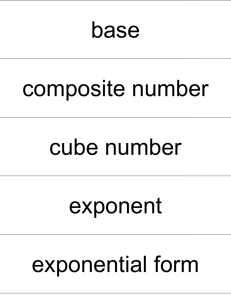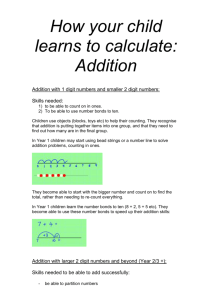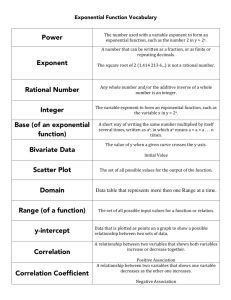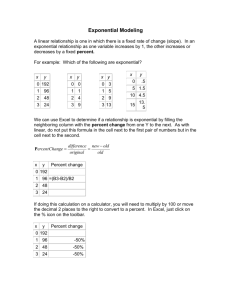engineering gatortrax math excellence project
advertisement
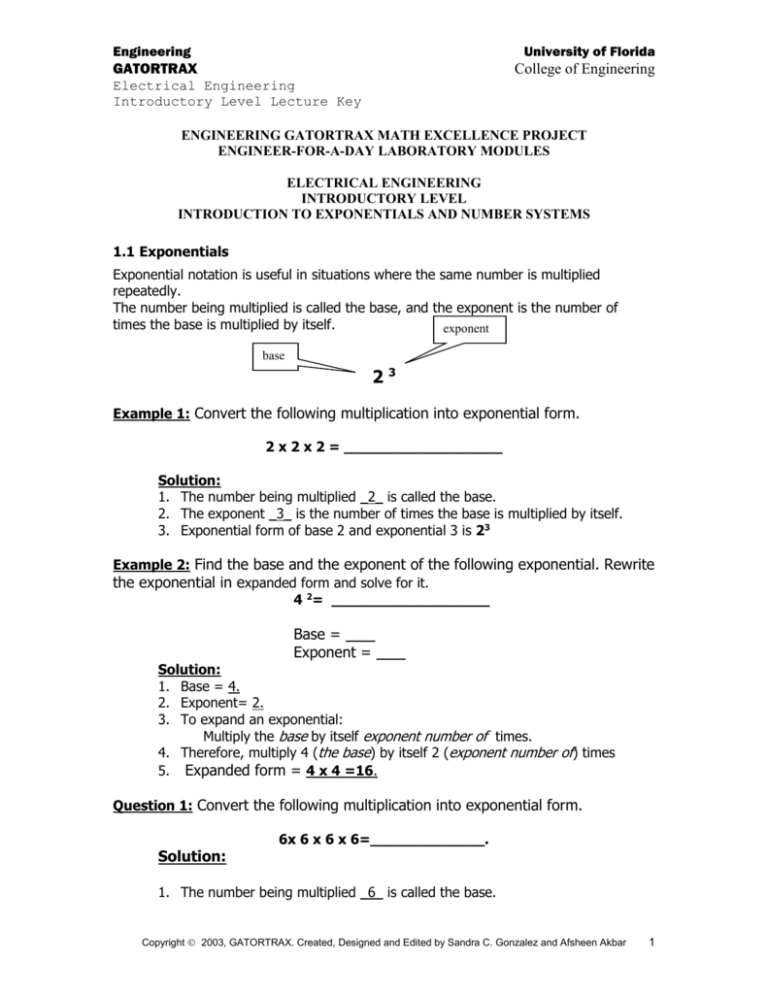
Engineering University of Florida GATORTRAX College of Engineering Electrical Engineering Introductory Level Lecture Key ENGINEERING GATORTRAX MATH EXCELLENCE PROJECT ENGINEER-FOR-A-DAY LABORATORY MODULES ELECTRICAL ENGINEERING INTRODUCTORY LEVEL INTRODUCTION TO EXPONENTIALS AND NUMBER SYSTEMS 1.1 Exponentials Exponential notation is useful in situations where the same number is multiplied repeatedly. The number being multiplied is called the base, and the exponent is the number of times the base is multiplied by itself. exponent base 23 Example 1: Convert the following multiplication into exponential form. 2 x 2 x 2 = __________________ Solution: 1. The number being multiplied _2_ is called the base. 2. The exponent _3_ is the number of times the base is multiplied by itself. 3. Exponential form of base 2 and exponential 3 is 23 Example 2: Find the base and the exponent of the following exponential. Rewrite the exponential in expanded form and solve for it. 4 2= __________________ Base = ___ Exponent = ___ Solution: 1. Base = 4. 2. Exponent= 2. 3. To expand an exponential: Multiply the base by itself exponent number of times. 4. Therefore, multiply 4 (the base) by itself 2 (exponent number of) times 5. Expanded form = 4 x 4 =16. Question 1: Convert the following multiplication into exponential form. Solution: 6x 6 x 6 x 6=_____________. 1. The number being multiplied _6_ is called the base. Copyright 2003, GATORTRAX. Created, Designed and Edited by Sandra C. Gonzalez and Afsheen Akbar 1 Engineering University of Florida GATORTRAX College of Engineering Electrical Engineering Introductory Level Lecture Key 2. The exponent _4_ is the number of times the base is multiplied by itself. 3. Exponential form of base 6 and exponential 4 is 64 Question 2: Find the base and the exponent of the following exponential. Rewrite the exponential in expanded form and solve for it. 56= __________________ Base = ___ Exponent = ___ Solution: 1. Base = 5_ 2. Exponent = 6_ 3. To expand an exponential: Multiply the base by itself exponent number of times. 4. Therefore, multiply 5 (the base) by itself 6 (exponent number of) times 5. Expanded form = 5 x 5 x 5 x 5 x 5 x 5 = 15625. Question 3: Find the base and the exponent of the following exponential. Rewrite the exponential in expanded form and solve for it. 123=________________. Base = ___ Exponent = ___ Solution: 1. Base = 12 _ 2. Exponent = 3_ 3. To expand an exponential: Multiply the base by itself exponent number of times. 4. Therefore, multiply 12 (the base) by itself 3 (exponent number of) times 5. Expanded form = 12 x 12 x 12= 1728. 1.2 Decimal Numbers Places Whole decimal numbers have a value, which depends on the place of each digit in the number. The decimal number places are ones, tens, hundreds, and so on. The following examples show the decimal place value for various positions. Example 3: Place each digit of the decimal number given below in the right place of the table. 4589 Copyright 2003, GATORTRAX. Created, Designed and Edited by Sandra C. Gonzalez and Afsheen Akbar 2 Engineering University of Florida GATORTRAX College of Engineering Electrical Engineering Introductory Level Lecture Key Thousands Hundreds Tens Units Solution: 1. 2. 3. 4. 5. Inspect the number from right to left. The right most number is in the units place or box. The next number to the left is in tens place or box. The number left to tens is in hundreds place or box. The leftmost number is in thousands place or box. Thousands 4 Hundreds 5 Tens 8 Units 9 Question4: Place each digit of the decimal number given below in the right place of the table. 9532. Thousands Hundreds Tens Units Solution: 1. 2. 3. 4. 5. We start looking at the number from right to left. The right most number is in units place. Going left, the next number is in tens place. The number left to tens is in hundreds place. The leftmost number is in thousands place. Thousands 9 Hundreds 5 Tens 3 Units 2 Copyright 2003, GATORTRAX. Created, Designed and Edited by Sandra C. Gonzalez and Afsheen Akbar 3 Engineering University of Florida GATORTRAX College of Engineering Electrical Engineering Introductory Level Lecture Key 1.3 Place Value Another way of writing numbers to show their place value is by expanded form. Every place in the decimal system, and in any other number system, has an exponential related to it. The exponential is written as follows: 1. The base, which is determined by the number system that is being used, in this case 10. 2. The exponential, which is determined by the place of each digit in the whole number for example units or tens, for the decimal number system. Here is the relationship between the place value and the assigned exponential Thousands 1000 Hundreds 100 Tens 10 Units 1 103 102 101 100 Example 4: Show the following decimal number in expanded form: 4589=_________________________. Solution: 1. Since the number given above is in decimal number system, all the digits of the number are multiplied by base 10 to the respected place power. For instance: The number at the units place gets multiplied by 10 0, and the number at the tens place will be multiplied by 101 and so on. 2. After multiplying all the digits with the exponential, add all the products to get the final number. This is shown below: Thousands 4 Hundreds 5 Tens 8 Units 9 4000 + 500 + 80 + 9 4 x1000 + 5x100 + 8x10 + 9x1 4 x 103 + 5x102 + 8x101 + 9x100 4589= (4x103) + (5x102) +(8x101) +(9x100). Copyright 2003, GATORTRAX. Created, Designed and Edited by Sandra C. Gonzalez and Afsheen Akbar 4 Engineering University of Florida GATORTRAX College of Engineering Electrical Engineering Introductory Level Lecture Key Question5: Show the following decimal number in expanded form: 593=_________________________. Solution: 1. Since the number given above is in decimal number system, all the digits of the number are multiplied by base 10 to the respected place power. For instance: The number at the units place get multiplied by 10 0, and the number at the tens place will be multiplied by 101 and so on. 2. After multiplying all the digits with the exponential, add all the products to get the final number. This is shown below: Thousands 0 Hundreds 5 Tens 9 Units 3 0 + 500 + 90 + 3 0 x 1000 + 5x100 + 9x10 + 3x1 0 x 103 + 5x102 + 9x101 + 3x100 593= (5x102) +(9x101) +(3x100). Question6: Show the following decimal number in expanded form: 36431=_________________________. Solution: 1. Since the number given above is in decimal number system, all the digits of the number are multiplied by base 10 to the respected place power. For instance: The number at the units place gets multiplied by 10 0, and the number at the tens place will be multiplied by 101 and so on. 2. After multiplying all the digits with the exponential, add all the products to get the final number. This is shown below: 36431= (3x104) + (6x103) + (4x102) +(3x101) +(1x100). Copyright 2003, GATORTRAX. Created, Designed and Edited by Sandra C. Gonzalez and Afsheen Akbar 5 Engineering University of Florida GATORTRAX College of Engineering Electrical Engineering Introductory Level Lecture Key 2.1 Number Systems We refer to Number Systems as the set of number we use to count or keep records in a specific situation. For example the most common number system is the decimal number system we use every day, from 0 to 9. In our regular vocabulary we also referred to a based twelve number system for example, when ordering a dozen donuts. Computers are also a great example of number systems, since they base all their computation on a binary number system, which means only two numbers. Let’s think of some other numbers system, as the example indicates. Example 5: List all the possible digits in the following systems: Base 4 Number System=__________. Base 2 Number System=__________. (also called binary system) Solution: 1. The number of digits present in a number system is as many as the base of the system. 2. In this case there are 4 digits in base 4 and 2 digits in base 2. 3. The digits start from 0 and goes upto the base number minus one, for instance it would go from zero to three for base four and zero to one for base two. 4. If we run out of numbers we use letters. 5. So in Base 4 Number System, the digits included are 0, 1,2, and 3. 6. In Base 2 Number System the digits included are 0 and 1. Question 7: List all the possible digits in the following systems: 9= ________________________________. 10=________________________________. 5 = ________________________________. 13=________________________________. Copyright 2003, GATORTRAX. Created, Designed and Edited by Sandra C. Gonzalez and Afsheen Akbar 6 Engineering University of Florida GATORTRAX College of Engineering Electrical Engineering Introductory Level Lecture Key Solution: 1. The number of digits present in a number system is as many as the base of the system. 2. The digits start from 0 and goes upto the base number minus one for instance it would go from zero to twelve for base thirteen. So the digits included in the following Base Systems are: 9= 0,1,2,3,4,5,6,7,8 10=0,1,2,3,4,5,6,7,8,9 5 = 0,1,2,3,4 13=0,1,2,3,4,5,6,7,8,9,A,B,C 2.2 Number Systems Place Values As we already discussed for decimal number, each digit of a number regardless of its base holds a value. The procedures to determine this value are the same as in the decimal system: 1. Find the base. This is determined by the number system that is being used, for instance decimal would use base 10 and octal base 8. 2. Add the exponential. This is determined by the place of each digit in the whole number for example units or tens, for the decimal number system. Example 6: Expand the number in various number systems 4573(base 8)=_________________________. 4132(base 5)= ________________________ . Solution: 1. Determine the base used for each number according to its Number System. In this case 8 and 5 respectively. 2. Determine the exponent corresponding to each place of the specified Number System. In this case 80 (units), 81(eights), 82(sixtyfours) and so on for base 8 numbers. For base 5 numbers it will be: 50 (units), 51(fives), 52(twentyfives) and so on. 3. All the products will be added to get the final number. 4. To expand the above number in base 8 multiply each digit by the exponential as follows: 4573= (4 x 83) + (5 x 82) +(7 x 81) +(3 x 80). 5. To expand the above number in base 8 multiply each digit by the exponential as follows: 4132= (4 x 53) + (1 x 52) +(3 x 51) +(2 x 50). Copyright 2003, GATORTRAX. Created, Designed and Edited by Sandra C. Gonzalez and Afsheen Akbar 7 Engineering University of Florida GATORTRAX College of Engineering Electrical Engineering Introductory Level Lecture Key Question8: Expand the number in various number systems 453(base 9)=_________________________. 4132(base 6)= _______________________ . Solution: 1. Determine the base used for each number according to its Number System. In this case it would be 9 and 6 respectively. 2. Determine the exponent corresponding to each place of the specified Number System. In this case 90 (units), 91(nines), 92(eightyones) and so on for base 9 numbers. For base 6 numbers it will be: 60 (units), 61(sixs), 62(thirtysixs) and so on. 3. All the products will be added to get the final number. 4. To expand the above number in base 9 multiply each digit by the exponential as follows: 453= (4 x 62) + (5 x 61) +(3 x 60). 5. To expand the above number in base 6 multiply each digit by the exponential as follows: 4132= (4 x 63) + (1 x 62) +(3 x 61) +(2 x 60). Copyright 2003, GATORTRAX. Created, Designed and Edited by Sandra C. Gonzalez and Afsheen Akbar 8
